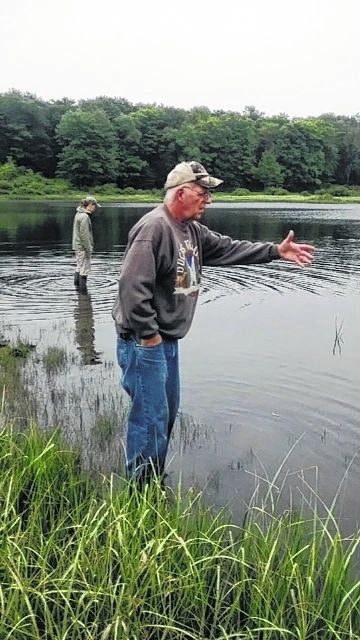Click here to subscribe today or Login.


Forkston Township — Bob Avery knelt down and examined the damp earth along the edge of Lower Bean Pond on State Game Lands 57 and liked what he saw.
Underneath the weathered remains of a stump, fragile sprouts of duck potato poked through the dirt.
Weeks earlier, Avery and fellow members of Ducks Unlimited, Delta Waterfowl and the Pennsylvania Game Commission, spent several days on a few ponds planting tubers and seeds to hopefully create a smorgasbord for waterfowl.
In addition, the PGC began drawing down the water levels of the ponds to expose more of the shoreline in an attempt to get the seeds already in the soil to sprout.
Lower Bean Pond was drawn down 10 to 15 feet, and Avery saw results.
“This hasn’t seen air for 9 years,” Avery said, referring to the last time the water levels were reduced. “In wetlands everything lays dormant, and when you draw it down the plants re-emerge.”
After the shoreline is exposed and vegetation establishes, it will be flooded again to give ducks access to the new food source. The Game Commission has water control structures on several ponds and the agency will continue to experiment with different water levels to provide the most vegetation for ducks.
While the groups wait for the shoreline to generate growth, they also took matters into their own hands by planting several plant species directly in the water.
Species planted included bur-reed, buttonbush, deep water duck potato, wapato duck potato, sago pond plant and wild rice and wild celery. Ponds that were planted include Upper Bean, Lower Bean and South Brook.
Avery said it was important to get the plantings done now so they provide a benefit to ducks in the fall.
“Right now the ducks that are here breed and leave because there’s nothing here to hold them,” Avery said. “I want to bring it back to the days where you could see 300 to 400 birds up here. That’s why we need to give them a fall food and another source for the summer so they’ll stay here.”
After the plantings establish, the ducks themselves can help the process along.
Avery said the seeds of some species, such as duck potato, will cling to the feathers of waterfowl and can be spread from pond to pond.
But the key, according to PGC waterfowl biologist Molly Giles, is to raise the water levels of the ponds and flood them shoreline again later in the year. That way ducks can not only come in contact with the seeds, but eat them to.
“With American bur-reed, the seed falls off in the fall and when we flood a pond it floats on the water,” Giles said. “The ducks can eat it and the rest will spread.”
Another benefit, especially in the summer, is the abundance of macroinvertebrates that appear on the new aquatic vegetation. Macroinvertebrates are an important food source for female ducks as it aids in egg formation, Giles said, and they are also gobbled up by ducklings.
“Everything we’re doing is beneficial to the ecosystem here,” Avery said.
In addition to the plantings, Avery said the groups will be creating islands out of dead trees and floating them out on Upper Bean Pond to provide ducks with nesting areas and protection from predators.
Avery and Giles will also return several times during the year to monitor the nesting success inside the dozen of wood duck boxes erected throughout the area.
And in between it all, Avery will count the ducks he sees on SGL 57 hoping the number one day increases to several hundred.
“As long as I’m able to do it, I’ll keep working toward that goal,” Avery said.





